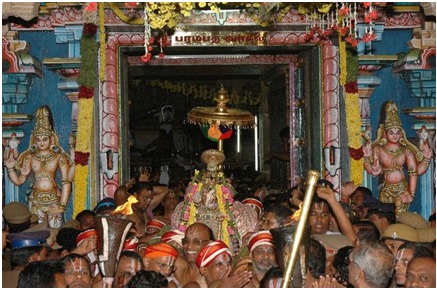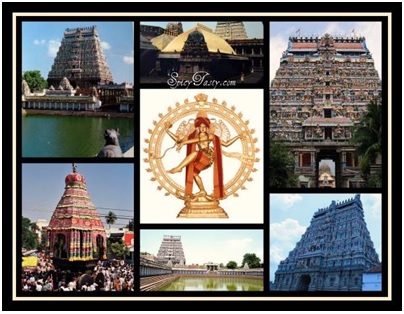Bhagavat Gita is often quoted to extol the greatness of Margazhi month.
Bhruhat sama tatha samnam, gayatri chandsam aham I
Masanam marga shirshah aham, rutu nam kusuma akarah II
Bhagavat Gita: Chapter 10 - sloka 35
"Of the sama veda hymns I am the bruhat sama; of the metres, I am gayatri.
Of the months, I am margasirsha, and of the seasons, I am the flowery spring."
Swami Dayananda Saraswathi says Gita is both ‘brahma-vidya and yoga-sastra’ and he reduces Brahma Vidya to a brief sentence – ‘tat twam asi’, or, ‘you are that’. Simple though this statement is, the underlying meanings of ‘twam’ and ‘tat’ are of course profound.
The first six chapters of Gita mainly deal with ‘twam, you’. From the seventh chapter, the subject matter shifts to ‘tat’, or ‘Isvara’ and the truth of Isvara is the central topics of chapter 7 to 12. The tenth chapter, Vibuti-yoga, presents the glory of Isvara. Even though He is everything, still, there are aspects of His glory that are particularly visible. We see this in the choice of our kshetras. Places of exceptional natural beauty - the confluence of great rivers, Prayag, or, modern day Allahabad, or the place of ‘Allah’; the island at the tip of India, Rameswaram; the Srirangam and Tiruvanaikkaval island in Cauvery; atop the Sapthagiri or the seven hills of Tirupathi – all these are places of glory that we have earmarked for a great temple and special worship.
God is everywhere but there are special places or things where His glory is extolled.
The month of Margasirsha, or, Tamil, Margazhi is one such aspect of Glory. The time of the day before sunrise is called the Brahma muhurtam, the most favourable time for spiritual practices. Our earthly year is deemed the equivalent of a day for devas. The whole of our month of Margasirsha is the equivalent of Brahma muhurtam for devas The worship of God done in this month, especially in the early morning, or Brahma muhurtam for us, is therefore considered particularly auspicious.
Margazhi - the Month earmarked for Prayers
Most of our celebrations and festivals fall during the six month dakshinayana period of Adi to Margazhi months in the Tamil calendar – the Upakarmas, Gokulashtami, Ganesh Chathurthi, Navarathri, Saraswathi Puja, Deepavali, Karthigai Deepam, etc., etc., - but none in Margazhi. Only when the month finishes and Thai month and Uttarayana period begin, do we celebrate the next major home festival of Sankaranthi or Pongal. Hanumat Jayanthi, Ramana Maharishi Jayanthi and Kanchi Mahaswamigal Aaradanai all fall in this month, but, no festive pujas and celebrations at home. There are no muhurtam days either in the month of margazhi for performing marriages.
The reason is that Margazhi is earmarked for prayers, especially, in public, singing and reflecting on His glory. There are various ways in which this is done.
Temples: Temples and mutts all have early morning, Danurmasa pujas. In the Kanchi Sankaracharya Mutt, for example, the first of the daily tri-kala pujas for Lord Chandramouleeswara, is performed starting 4 am each day during this month.
Morning Street Bhajans: This is the month for early morning street bhajans in Tamilnadu – to go around in groups, especially around temples, singing bhajans, usually ending in a temple in time for the Danurmasa puja and the prasadam following it. Children and women wake up early and draw beautiful patterns, or kolams, outside their houses with rice flour and border it with red colored powder. In the middle little cow dung is kept with a flower of the pumpkin adorning it, as a welcome to the bhajan parties!
Tiruppavai: Thiruppavai belongs to the Pavai genre of songs, a unique Tamil tradition sung in the context of the Pavai vow observed throughout the month of Margazhi. These are 30 pasurams, or verses, written by Sri Andal, one verse for each day of the month. It appropriately ends with the statement that whosoever sings these thirty verses, will receive the God’s blessings and happiness and peace of mind - ‘thiruvarul petri inburuvar’ in Tamil.
Tiruvembavai: This is the Shaivaite equivalent of Tiruppavai and is part of Manicka Vasagar’s Tiruvasagam. Tiruvasagam in Tamil means ‘Holy script’ and there is a saying – ‘tiruvasagattu uruvathar evvasagathum urugar’ meaning, ‘if Tiruvasagam does not move you to tears, nothing else will.’ Thiruvembavai is so world famous, it is said that even today during the coronation of Thailand kings, this is sung!
Srirangam Vaikunta Ekadasi

Srirangam Vaikunta Ekadasi
In Vaishnavaite temples this is the most important festival period. In Srirangam, the 21 day festival consists of two parts: first ten days called pagal pathu (morning part) and the last ten days called ira pathu (night part). During these days, the main Sri Ranganathaswamy deity is adorned with pearls, or ‘muthangi sevai’ and there are special pujas. The high point of the festival is Vaikuntha Ekadashi. On this day, Lord Ranganatha is adorned by an armor of diamonds (rathnaangi sevai) and brought to the thousand-pillared hall from the sanctum sanctorum through the northern gate known as Paramapada Vasal, the gate to Vaikuntha. This gate is opened once in a year, only on the Vaikuntha Ekadashi day. It is believed that anyone who goes through the Paramapada Vasal will reach Vaikuntham. There are similar festivals in all vaishnavaite temples – in Tirupathi one goes through Vaikunta Dwaram on the Ekadasi day.
Chidambaram Aardra Darshan

Chidambaram Aardra Darshan
Similar to Vaikunta Ekadasi in Srirangam, arguably the most important festival in Chidambaram and other Shaivaite temples is Aardra darshan. This takes place on the day of confluence of full moon day and the star aardra (Tiruvadurai in Tamil) – this occurs only once in a year during the month of margazhi and is the longest night in the year. Early morning there is the abhishekam for Lord Nataraja in the Chidambaram temple and later there is a temple procession where the Utsava murthy is taken out for darshan.
Kanchi Mahaswamigal tells us that Aarudra Darshan is the equivalent of Revelation of the Lord. “The meaning of the Sanskrit word Aardra is wet, or, dripping: in the context of Aardra darshan, it signifies wet with compassion, or, ‘nanainda manasu’ in Tamil. During margazhi, Nature which is but a manifestation of God, puts on a cloak of dew. The combination of soothing rays of the full moon and the dripping dew enveloping the earth is wonderful. On that day, we should all perform an abhishekam to Isvara, whose heart overflows with compassion, and seek his blessings. The Nataraja form of Isvara also highlights brahmanada and that everything that happens is His divine sport. And, our only sanctuary is His slightly inclined foot, or ‘kunchita paadam’, in Tamil!”
This year, the Danurmasa puja begins on 16th December, 2013; Aardra Darshan falls on 18th December, 2013, and Vaikunta Ekadasi on 11th January, 2014. In Srirangam the ‘pagal pathu’ begins on 1st January, 2014; Vaikunta Ekadasi will be on 11th January, 2014, the same day that the ‘Ira pathu’ begins. The festival concludes on 21st January.
South Indian Society carries in its website one Tiruppavai song per day during Margazhi.
May we all do our bit of prayers during this month: in the temples, as part of bhajans, and, in our homes.